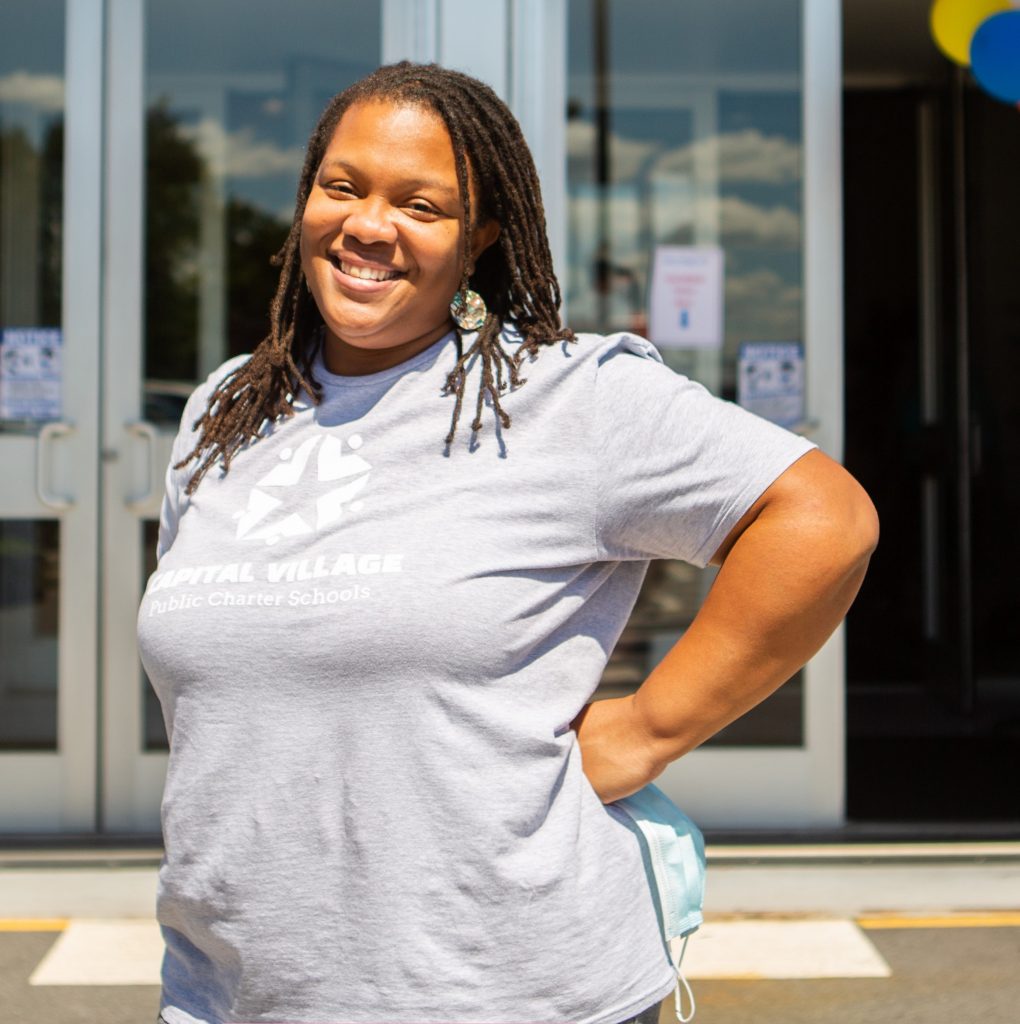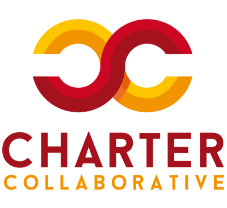
Monica Green
Founder & Executive Director,
Capital Village Public Charter Schools
Capital Village Public Charter Schools
Location: Washington, DC
Year Opened: August 2020
Student enrollment: 52
Grades served: 5-6
Website: www.capitalvillageschools.org
Student Demographics
Black/African-American: 88%
Native: 2%
White: 6%
Two or more races: 4%
Homeless Students: 6%
FRPM/FRPL %: 100%
Students with Disabilities: 40%
ELL/ESL Students: 4%
A PASSION FOR HELPING MIDDLE SCHOOLERS THRIVE
I’ve always had a love of learning and always loved reading and literacy. Around middle school, I really became aware of the differences in education, because I bounced around between private and public schools. I was able to see very clearly the “haves and have nots” situation in education, and I was starting to see injustice in the world more broadly. I wondered why I was able to be given this great experience–classes that weren’t interrupted by drama and trauma, teachers who weren’t in and out, teachers who pushed me to take honors classes–just because my family could pay for tuition. I realized that my family could choose the educational environment they wanted me to have, but that wasn’t the case for everyone.
After college, I taught middle school for 15 years. I really enjoy middle school learners, because they’re at a very impressionable age where they’re super curious and unpredictable. Getting into my 3rd or 4th year of teaching, I started to see a pattern of it being really difficult to reach all of the students in my classes, especially in urban environments with a lot of trauma and a lot of need, including social-emotional needs. I felt I wasn’t able to be most effective within the constraints of a traditional school setting. I started playing around with different models and different teaching strategies, feeling a sense of urgency. In graduate school, I learned about Expeditionary Learning and continued to tinker in my classroom in different ways.
I knew I wanted to start something new, but I didn’t know that it would be a different school until I started designing. About 4-5 years ago, I realized it needed to be a different entity. I put together a design team made up of likeminded professionals: other teachers I had taught with before, a college friend, school leaders, people I had talked and grown with throughout my career. There were eight of us on the core team and we sought other folks who had expertise in certain areas like curriculum and instruction, special education, experience with non-profits, knowledge of the law. I got involved with 4.0 Schools who helped to refine the idea and connected me to CityBridge, which helped to propel the idea, because I could work on it full time.
IT TAKES A VILLAGE TO DESIGN A SCHOOL
The design of the Capital Village School came out of a lot of research and community engagement. My vision was really trying to do middle school right. This was an area of need in DC. The most important research was with middle school students, parents, and teachers. I started talking to them about some of the pain points and how middle school could be better. We also talked to high school teachers and college professors to find out what students coming out of middle school lacked. We used surveys, design thinking, and empathy interviews, some of which I learned about through 4.0 Schools and my CityBridge fellowship.
From our research, three things stuck out very clearly. (1) School needed to be real. Students hated their time in school, because it wasn’t connected to anything real. They’re living in communities where a lot of stuff is going on that’s making them angry, so let’s be the space where they can talk through those issues. (2) Students and parents wanted school to be a place where they knew someone cared about them, so we designed a smaller school. And lastly, (3) there was the need for a whole child approach–families wanted school to be a place where students could become better people.
Our model is built around real world, student-centered/led, and individualized learning. We’re a small village focused on the whole child. Some pieces of our model are not very convenient. For example, fewer kids means less money, so we have to be more strategic and lean. We consider ourselves a community school, so we’ve done a lot of community recruitment in Ward 5, the community we’re in. Our mission is to be a school where all students can come and be pushed to their full potential. We have a lot of students with special education needs in our school and a very vibrant and exciting special education program. Our most gung-ho parents are parents of special education students, because our mission of being individualized and student-centered really speaks to them.
IMPACTS OF COVID-19
We weren’t thinking we were going to be opening a school during a pandemic. We never thought we would not be in a building with students. COVID-19 has pushed us to be innovative with our model. Right now, our focus has been on building a strong student and staff culture and community. We’re really focused on getting kids to come to virtual school. We’re making sure they know that they are welcome here, they have someone they can talk to, and we will help families with whatever is going on so they can be whole. We’re connecting families to family therapists and coaching families around building learning environments in their home. We have a soft opening between 8:30-9 so students can check in with crew leaders. If a student hasn’t logged on, adults are calling and texting, because we want all of our kids there every day. It’s about knowing if they’re okay and if there’s anything wrong. We’ve been fortunate that we’re almost always able to reach someone and get the kid online.
We’ve focused a lot of effort on making sure everyone has adequate WiFi, making sure Chromebooks are working correctly, and making sure the online environment is organized so that students can navigate it. This has also forced us to be innovative. We’ve switched around different video-conferencing platforms, created more video lessons, and started checking in on smaller groups. We’re always asking, “How can we do this better?” I’m seeing places where some aspects of our model are still very traditional and thinking about how we can be more innovative. I want to offer more personalized instruction, more student-paced instruction. I want to get to a place where students are logging on when they want or need to instead of at a standardized time.
We check in very often as a school community. We have collaborative planning time every day from 3-4pm where instructional staff come together. People can shout out and share what they’re doing. We’re looking into how we can use Google Classroom or another platform to highlight and showcase things that are going well within the school. A big piece of us sharing and learning together is the staff culture. Staff members will text each other to help each other out. We’ve built a community where staff aren’t afraid to ask for help. Teachers are curious and motivated to do the best job possible.
There’s something about being in students’ homes that makes the impact of their home lives so incredibly obvious. You see how that impacts students. We already wanted to focus on the whole child and wanted to do community connections. The pandemic has accelerated that. At times, it’s also been traumatizing for teachers to see and try to push through what’s happening in the home environment. We’re trying to open our building by December for a select number of students, because it’s very clear that in some cases the home environment isn’t conducive to learning.
In some cases, parents are working and aren’t there, but in many cases, parents are there and are supporting students. I love how families are more in tune with what’s happening in their students’ learning. We’ve been leaning on families and asking for feedback. Teachers feel that their voice carries into the home, which is another way of being accountable to what we’ve promised parents.
CHARTER LEADERS OF COLOR MATTER
Being a leader of color has always been important to me, because I have an eye towards folks on the margins. We have to be a school where minorities, students with special needs, students with varying sexual orientations are successful. I always think about what Caroline Hill says: If you design for the margins, all students benefit. We have
to have a program where kids who look like me are going to be successful.
When doing the research for the school and seeing the disparities in DC around students of color, there are a group of folks who should be on the forefront of policy, but the statistics haven’t changed fast enough. We still have statistics of students of color with special needs performing in single digits for college and career readiness standards. If you see it year after year, you get very angry about it. It gives you a sense of urgency that laser focuses your perspective and catalyses action.
I have a Black son and I’m married to a Black man. It’s very clear how life and death education is. Being a Black woman of color, you come against feeling like you have to assert yourself in a particular way as a leader in an industry that’s still dominated by white men. I make sure I show up in a way that enables my students to be well taken care of. I become very motivated when students and families see themselves in me. I never thought about that until it happened. It’s a plus, but it’s also a pressure. I want to be a model of success for my students – for them
to see possibilities in my example.
